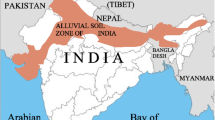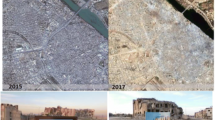Abstract
Low-volume roads (LVRs) represent an important part of road network in Burkina Faso and in many countries in west Africa (more than 80%). These roads are mainly unpaved and built-in lateritic soils due to the socio-economic conditions and to the abundance of lateritic soils in these tropical regions. The design and the quality compaction control of these roads are respectively performed using Californian Bearing Ratio (CBR) index and dry unit weight determined through densitometer or sand replacement method. But such methods are known to be time-consuming and expensive unlike dynamic cone penetrometer thanks to which, it is possible to provide quickly Dynamic Cone penetration (or often penetrometer) (DCP) index and predict CBR index and dry unit weight or the compaction level through correlation models. The real challenge is that such correlations depend on dynamic penetrometer type, the type of soils and their water conditions rarely considered in the literature. In this paper, after literature review and experimental tests, specific correlations are performed for lateritic soils using light DCP Pandito® and taking into account three water conditions (dry, medium and wet). The analysis shows a good correlation between the compaction level or CBR and DCP indexes. The results were satisfactory and a single model taking into account any water conditions was performed for estimating CBR index and the compaction level through DCP index for respectively design and compaction control of LVRs in lateritic soils using DCP Pandito®.














Similar content being viewed by others
Abbreviations
- AASHTO:
-
American Association of State Highway and Transportation Officials
- AFNOR:
-
Association Française de Normalisation
- ASTM:
-
American Society for Testing and Materials
- CEBTP:
-
Centre Expérimental de recherches et d’études du Bâtiment et des Travaux Publics
- CBR:
-
Californian Bearing Ratio
- DCP:
-
Dynamic Cone Penetrometer
- Eq:
-
Equation
- Fig:
-
Figure
- GC:
-
Clayey gravels
- GM:
-
Silty gravels
- GP:
-
Poorly-graded gravels
- GTR:
-
Guide de Terrassement Routier
- HRB:
-
High Research Board
- IFSTTAR:
-
Institut Français des Sciences et Technologies des Transports, de l’Aménagement et des Réseaux
- LL:
-
Liquid Limit
- LVR:
-
Low- Volume Roads
- Max:
-
Maximum
- NF P:
-
Normes Françaises
- OMC:
-
Optimum Moisture Content
- PI:
-
Plasticity Index
- PSD:
-
Particles Size Distribution
- SETRA:
-
Service d’Etudes Technique, des Routes et Autoroutes
- SLA:
-
Sandy lateritic soils
- SLP:
-
Coarse lateritic soils
- SPT:
-
Standard Penetration Test
- UK:
-
United Kingdoms
- USA:
-
United States of America
- USCS:
-
Unified Soil Classification System
- W:
-
Moisture content
- WMP-OMC :
-
Optimum moisture content of modified proctor
- α:
-
Chamber boundary effects
- a, b and c:
-
Coefficients depending on the nature of soils
- Dmax :
-
Maximum diameter of soils
- ϕ:
-
Diameter
- γd :
-
Dry unit weight of soils
- γd MP-MAX :
-
Maximum dry unit weight of modified proctor
- k:
-
Ratio between soaked and unsoaked CBR, depending on the type of soils and their moisture contents
- qd :
-
Cone resistance
- W:
-
Moisture content
- WMP-OMC :
-
Optimum moisture content of Modified Proctor
References
Pratico, F., Saride, S., & Puppala, A. J. (2016). Comprehensive life-cycle cost analysis for selection of stabilization alternatives for better performance of low-volume roads. Journal of the Transportation Research Board, Washington, United States, 2204, 120–129.
AASHTO (1993), Guide for design of pavement structures, 1993. American Association of State Highway and Transportation Officials, Washington, Etats Unis, 1993e éd., vol. 1.
Buchanan, M. D. (1807). Journey from Madras through the countries of Mysore, Canara and Malabar. East India Company, London. In three volumes.
Persons, B. S. (1970). Laterite: Genesis, Location, Use. Plenum N. Y.; Springer Science & Business Media. https://doi.org/10.1007/978-1-4684-7215-8.
Ampadu, S., Ackah, P., Nimo, F., & Boadu, F. (2016). A laboratory study of horizontal confinement effect on the dynamic cone penetration index of a lateritic soil. Transportation Geotechnics, 3(106), 32.
Gansonré, Y., Breul, P., Bacconnet, C., Benz, M., & Gourvès, R. (2019). Prediction of in-situ dry unit weight considering chamber boundary effects on lateritic soils using Panda® penetrometer. International Journal of Geotechnical Engineering. https://doi.org/10.1080/19386362.2019.1698211
CEBTP. (1984). Guide pratique de dimensionnement des chaussées pour les pays tropicaux, 1984e éd. Paris, France: Centre Expérimental de Recherches et d’Etudes du Bâtiment et des Travaux Publics.
Ghafghazi, M. (2011). Towards comprehensive interpretation of the state parameter from cone penetration testing in cohensionless soils, Civil Engineering, University of British Columbia, Vancouver, Canada.
Pournaghiazar, M. (2011). The cone penetration test in unsaturated sands, Civil and Environnemental Engineering, University of New South Wales, Sydney, Australia.
Gabr, M. A., Coonse, J., Lambe, P. C. (2001). A potential model for compaction evaluation of piedmont soils using dynamic penetrometer. Geotechnical Testing Journal, ASTM International, 24(3), 308–313.
Scala, A. J. (1956). Simple methods of flexible pavement design using cone penetrometers. New Zealand Engineering, 11(2), 34–44.
Sowers G., Hedges C., (1966). Dynamic cone for shallow in-situ penetration testing, in Vane Shear and Cone Penetration Resistance Testing of In-Situ Soils, ASTM International, Consulté le: 18 septembre 2023. [En ligne]. Disponible sur: https://www.astm.org/stp44629s.html.
Nguyen, B., & Mohajerani, A. (2014). Determination of CBR for fine-grained soils using a dynamic lightweight cone penetrometer. International Journal of Pavement Engineering, Melbourne Australia, 16, 180.
AS 1289.6. 3.2 (1997). Methods of Testing Soil for Engineering Purposes, Soil Strength and Consolidation Tests, Determination of the Penetration Resistance of a Soil, 9 kg Dynamic Cone Penetrometer Test, Sydney », New South Wales Aust.
Kleyn, E. G., Maree, J. H., Savage, P. F. (1982). Application of a portable pavement dynamic cone penetrometer to determine in situ bearing properties of road pavement layers and subgrades in South Africa. Proc. 2nd european symposium on penetration testing, Amsterdam, 1, 277–282.
ASTM International. (2009). Standard test method for use of the dynamic cone penetrometer in shallow pavement applications. ASTM D6951/D6951M-09. West conshohocken, United States. of America (USA).
Van Vuuren D.J., (1969). Rapid determination of CBR with the portable dynamic cone penetrometer, Transp. Res. Board, no 01409807, p. 3 pages.
DIN 4094, (2002). German Standard for Subsoil field investigations, part 1 : Cone penetration test.
Cearns P. J. & McKenzie A. (1988). Application of dynamic cone penetrometer testing in East Anglia, in Penetration testing in the UK: Proceedings of the geotechnology conference organized by the Institution of Civil Engineers and held in Birmingham on 6–8 July 1988, Thomas Telford Publishing, p. 123–127. Disponible sur. https://www.icevirtuallibrary.com/doi/abs/10.1680/ptituk.13773.0018.
Chaigneau, L (2001). Caractérisation des milieux granulaires de surface à l’aide d’un pénétromètre. Thèse, Université Blaise Pascal, Clermont II, Clermont Ferrand, France.
Webster, S. L., Grau, R. H., Williams, T. P. (1992). Description and application of dual mass dynamic cone penetrometer. Army engineer waterways experiment station vicksburg ms geotechnical lab.
Coonse, J. (1999). Estimating California bearing ratio of cohesive piedmont residual soil using the Scala dynamic cone penetrometer. North Carolina State University, Raleigh, North Carolina.
Gabr, M. A., Hopkins, K., Coonse, J., & Hearne, T. (2000). DCP criteria for performance evaluation of pavement layers. Journal of Performance of Constructed Facilities, 14(4), 141–148.
Harison, J. A. (1989). In situ CBR determination by DCP testing using a laboratory-based correlation. Aust. Road Res, 19(4), 313–317.
Livneh, M., Ishai, I., Livneh, N. A. (1995). Effect of vertical confinement on dynamic cone penetrometer strength values in pavement and subgrade evaluations. Transportation Research Record, TRB, Washington DC, 1473, 1–8.
Smith, R. B., & Pratt, D. N. (1983). A field study of in situ Californian bearing ratio and dynamic cone penetrometer testing for road subgrade investigations. Australian Road Research, Transportation Research Board, 13(4), 285–293.
Livneh M., (1987). Validation of correlations between a number of penetration tests and in situ California bearing ratio 438 tests, Transportation. Research. Record., 1219, 56‑67.
Ese D., Myre J., Noss P., & Vaernes, E. (1994). The use of dynamic cone penetrometer (DCP) for road strengthening design in Norway, in 4th International Conference, Bearing Capacity of Roads and Airfields.
NCDOT.(1998). Correlations between Californian bearing ratio (CBR) and dynamic penetrometer index (DCP). North Carolina department of transportation, Raleigh, North Carolina, United State of America (USA).
Bellotti, R. (1984). Chamber size effects and boundary conditions effects. United Kingdom: University of Southampton, pp. 437–445.
Schnaid, F., Houlsby, G. T. (1991). An assessment chamber size effects calibration of in situ tests in sand, presented to Soil Mechanics Report Number 110/90, in 3, vol. 41. University of Oxford, UK: Department of Engineering Science, pp. 437–445.
Harison, J. A. (1987). Correlation between California bearing ratio and dynamic cone penetrometer strength measurement of soils, Ground Engineering group, Bandung, Indonesia, pp. 1–12.
SETRA-IFSTTAR. (2000). Guide Technique pour la réalisation des remblais et des couches de forme, fascicule I, principes généraux, p 166, 2000 éd. Paris, France: Service d’Etudes Techniques des Routes et Autoroutes/Institut Français des Sciences et Technologies des Transports, de l’Aménagement et des Réseaux.
AASHTO. (1986). M 14-2- Standard Specification for Transportation Materials and Methods of Sampling and Testing, American Association for State Highway and Transportation Officials (14th edition),Washington DC, United State of America (USA).
Rodrigues J. K. G, Reiffsteck P, Auriol J. C, Ndaye M. (2010). Rationalisation de l'utilisation des sols lateritiques en corps de chaussée durable et de faible coût. 28èmes Rencontres Universitaires de Génie Civil (RUGC/2010). Session Ouvrages - Bitume, page 1122.
Corps of Engineers (1957). The Unified Soil Classification System. Technical Memorandum no.3.37, 193 revised in 1957. U.S. Army Engineer Waterways Experiment Station, Mississipi, United States of America.
Chaigneau, L., Gourvès, R., & Bacconnet, C. (2000). Penetration test coupled with a geotechnical classification for compaction control, présenté à An international conférence on geotechnical & geological Engineering, Melbourne, Australia. GeoEngineering, 2000, 6.
Gansonré, Y., Breul, P., Bacconnet, C., Benz, M., & Gourvès, R. (2021). Estimation of lateritic soils elastic modulus from CBR index for pavement engineering in Burkina Faso. International Journal of Pavement Research and Technology, 14(3), 348–356. https://doi.org/10.1007/s42947-020-0118-9
Ampadu, S. I. K., & Fiadjoe, G. J. Y. (2015). The influence of water content on the Dynamic cone penetration index of a lateritic soil stabilized with various percentages of a quarry by-product. Transportation Geotechnics, 5, 68–85.
Ampadu, S. I., & Arthur, D. T. (2022). The field compaction of lateritic pavement layers in a tropical environment. Transportation Engineering, 9, 100120.
George, V., Rao, N. C., & Shivashankar, R. (2009). PFWD, DCP and CBR correlations for evaluation of lateritic subgrades. International Journal of Pavement Engineering, 10(3), 189–199.
Acknowledgements
The authors of this paper would like to express their acknowledgements to many institutions, companies (mainly Sol Solution and the ministry of infrastructure of Burkina Faso) and persons, who have contributed in this research and paper. They would like to pay a special tribute to Claude Bacconnet, Professor, researcher, assistant director at Polytech Clermont and co-author of these works, passed away April 10, 2021. You have been an exceptionally good person, in the service of others that I have had the chance to meet, you will always be on my mind.
Funding
This work was mainly supported by Sol Solution (in France) and also Vectra (in France) and the ministry of infrastructures of Burkina Faso.
Author information
Authors and Affiliations
Corresponding author
Ethics declarations
Conflict of interest
The authors declare no potential conflict of interest.
Rights and permissions
Springer Nature or its licensor (e.g. a society or other partner) holds exclusive rights to this article under a publishing agreement with the author(s) or other rightsholder(s); author self-archiving of the accepted manuscript version of this article is solely governed by the terms of such publishing agreement and applicable law.
About this article
Cite this article
Gansonré, Y., Breul, P., Bacconnet, C. et al. Estimation of CBR index and Compaction Level Through DCP Index for Design and Compaction Control of Low-Volume Roads in Lateritic Soils. Int. J. Pavement Res. Technol. (2023). https://doi.org/10.1007/s42947-023-00394-9
Received:
Revised:
Accepted:
Published:
DOI: https://doi.org/10.1007/s42947-023-00394-9




